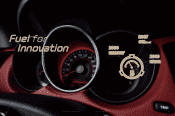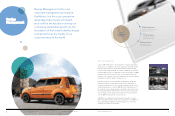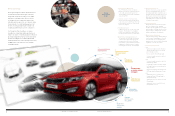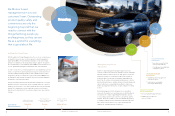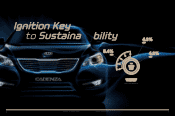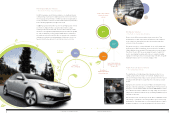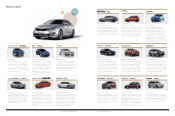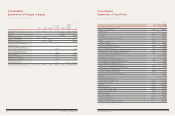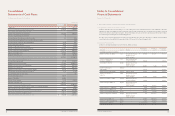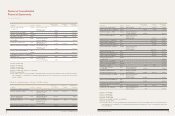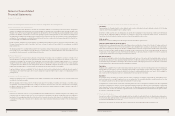Kia 2010 Annual Report Download - page 22
Download and view the complete annual report
Please find page 22 of the 2010 Kia annual report below. You can navigate through the pages in the report by either clicking on the pages listed below, or by using the keyword search tool below to find specific information within the annual report.
An HEV is basically a car with two powerplants – one traditional internal
combustion-type engine and one battery-powered electric motor. The fuel
efficiency and power performance of HEVs have improved significantly in
recent years thanks to intensive research and development by automakers
and cooperating organizations throughout the world.
In 2009, Kia launched its first HEV car, the Forte LPi Hybrid, which offered
low emissions, high performance and great value thanks to unique
technologies developed in Kia’s labs. The next commercial project will be
the launch of the Optima (K5) Hybrid in North America and Korea. By 2012,
we expect to apply Kia’s exclusive parallel hybrid system to what will be
the world’s most fuel-efficient HEVs. Also, to respond to the competitive
challenges posed by the increasing popularity of full-electric vehicles, we
have prioritized the development of cars that run solely on electricity.
HEV (Hybrid Electric Vehicle)
– The Next Frontier of Sustainability
Electric vehicles (EVs) are powered by electric motors alone. Their
widespread use in urban environments will make a strong contribution
to the reduction of urban pollution, as they do not produce any direct
emissions of greenhouse gases.
Kia’s quest to produce a commercially-viable electric vehicle began with
the Besta van in 1986, followed by an electric model of the Sportage in
1999. In 2010, we showcased the PoP, a fancy and fun concept car, at the
Paris Motor Show. In 2011, we are preparing the launch of a light CUV
electric car, and going forward we will continue to expand our leading-
edge green technologies into an ever broader range of models, along with
building the infrastructure for convenient charging of EVs.
The ideal that all eco-friendly transportation developers strive for is a
car that operates with zero reliance on fossil fuels. Hydrogen fuel cell
vehicles offer that potential, relying on power generation from the reaction
of hydrogen with atmospheric oxygen that emits only water as a waste
product.
Hydrogen-powered vehicles are an area of R&D in which Kia Motors has
built up a competitive advantage, as exemplified by the Mohave (known as
‘Borrego’ in overseas markets) FCEV developed in 2009 and able to travel
up to 758km at speeds up to 160 km/h on a single charge. The prototype’s
robustness in real-world conditions was proven during a 2,655km run from
San Diego to Vancouver.
Our development fuel cell technologies stretch back to 1998 thanks to Kia’s
early strategic commitment to becoming a leader in green car technology
and production. Our ultimate aim is to scale up mass production of and to
dominate the market for economical hydrogen fuel cell electric vehicles.
EV (Electric Vehicle)
– The Path to Sustainable Mobility
FCEV (Fuel Cell Electric Vehicle)
– The Global Benchmark
2012
2011
2010
2009
Small-scale production
of fuel cell electric
vehicles
Unveiling of
Optima (K5) Hybrid
in North America
Launch and small-scale
distribution of light CUV
electric cars
Launch of
Forte LPi Hybrid
EcoDynamics
ROADMAP
44 COMPONENTS OF SUSTAINABLE GROWTH 45
KIA MOTORS ANNUAL REPORT 2010



